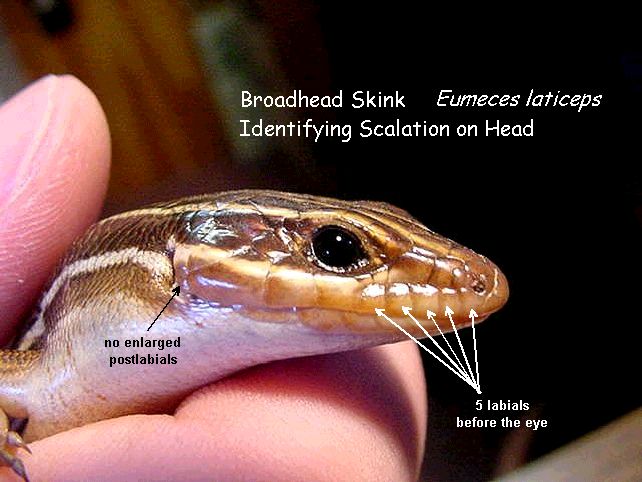The Lined Skinks (Plestiodon, formerly Eumeces)
Five-lined Skink (Plestiodon fasciatus , formerly Eumeces fasciatus )
Southeastern Five-lined Skink (Plestiodon inexpectatus, formerly Eumeces inexpectatus)
Broadhead Skink (Plestiodon laticeps, formerly Eumeces laticeps)
Three species of Lined Skinks (Plestiodon) are native to South Carolina. All three species may potentially be found throughout the state. These lizards are also found within much of the eastern United States. The Five-lined Skink has the widest range of the three, while the Southeastern Five-lined Skink, which is found only in the southeastern coastal states from Virginia to Mississippi plus parts of Tennessee and Kentucky, has the smallest range.
The young of each of these species begin life looking very similar. Their bodies are black with yellow stripes running the back and sides. Each typically has five stripes, two on each side and one down the middle of the back. They also have brilliant-blue tails. These little lizards have smooth, shiny scales.


As the juveniles mature, the blue color on the tail slowly disappears. Also, the black background color turns toward brown. Mature females retain their lines. Females retain the blue on their tails longer than the males. The mature males turn more brown and their stripes fade or disappear. During the breeding season, the jaws and heads of the mature males turn bright red.
The Five-lined and Southeastern Five-line Skinks grow to about 8 inches in total length. The Broadhead Skink grows to about 10 to 12 inches in total length and has a bulkier body than the other two species. The Broadhead Skink is the largest species of legged lizard native to South Carolina.




Because the young lizards, with their blue tails, look so differently from the mature lizards, many people mistakenly believe they are a different species from the adults.
These similar species can be positively identified by examining their scalation. The Southeastern Five-lined Skink can be differentiated from the Five-lined and Broadhead Skinks by the undertail scales. The Southeastern Five-lined Skink has scales of approximately the same size, while the Five-lined and Broadhead Skinks have a row of broader scales down the middle of the tail. The Five-lined Skink can be differentiated from the Broadhead Skink by the scales on the face. The Five-lined Skink has 4 labials and 2 enlarged postlabials, while the Broadhead Skink has 5 labials and no enlarged postlabials




Return to SC Lizard Index
updated: April 21, 2009
Contact: South Carolina Reptiles and Amphibians